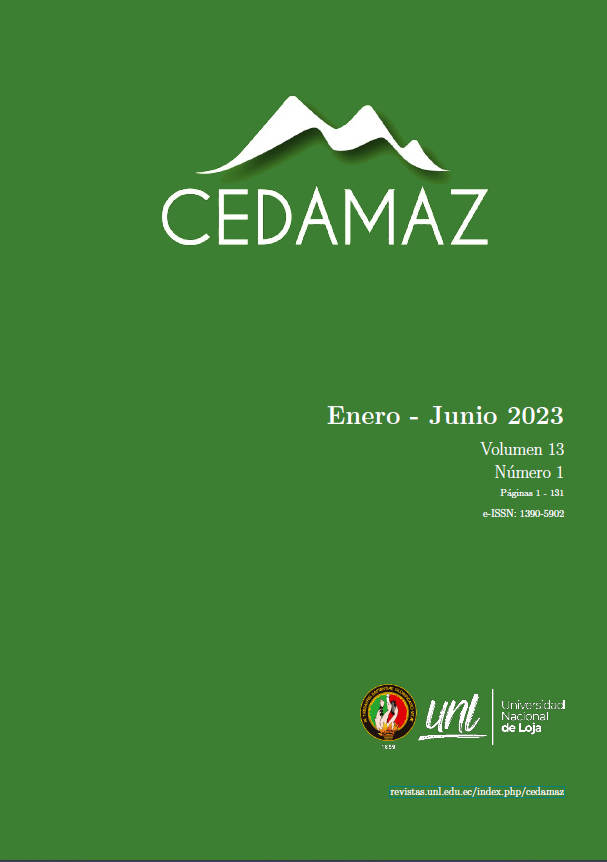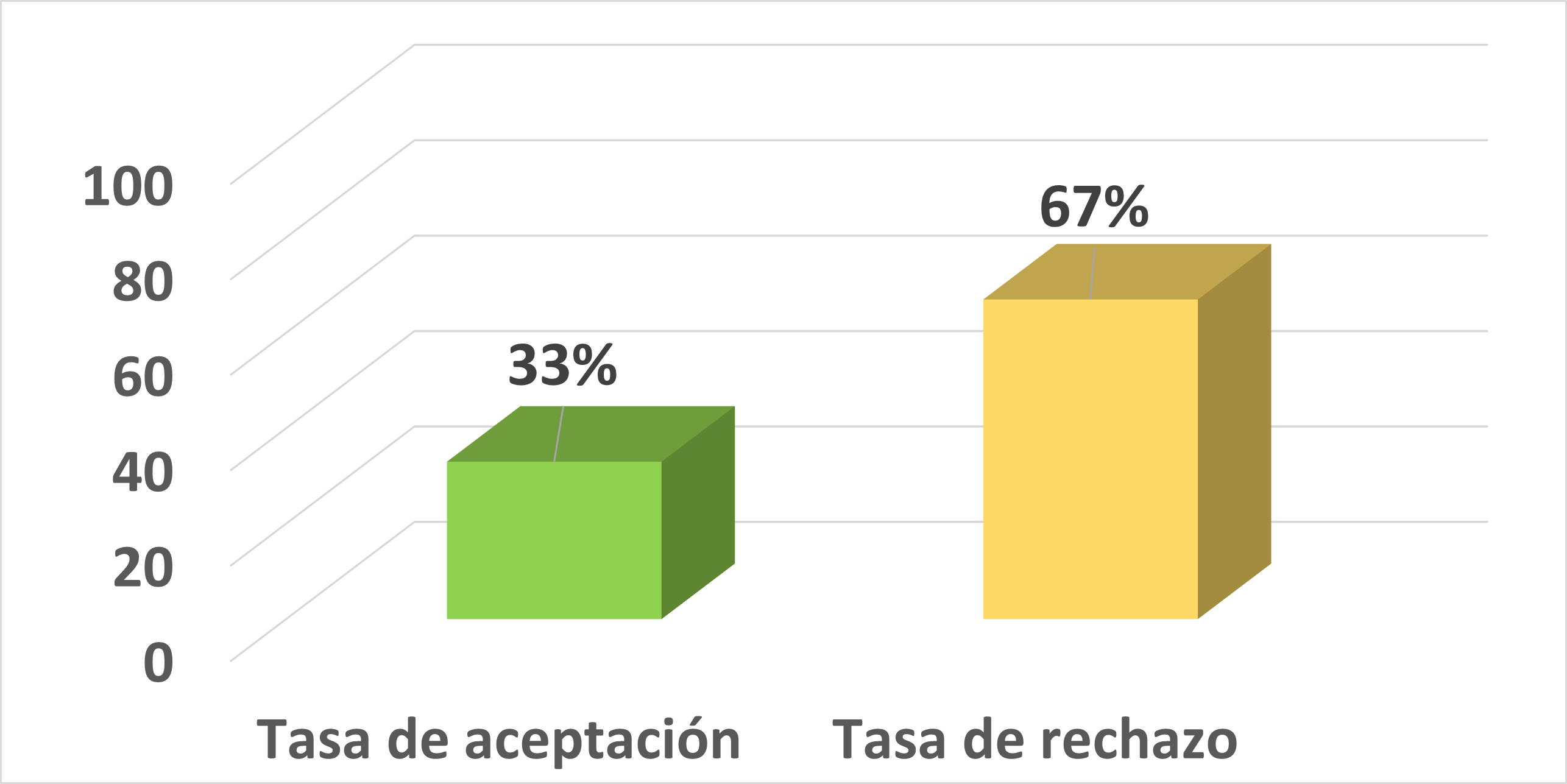Vocal exception: Indicator of stress in cattle
DOI:
https://doi.org/10.54753/cedamaz.v13i1.1763Keywords:
Bienestar animal, Vocalización, Ganado bovino, EstrésAbstract
The increase in the number of bovines makes it difficult for the farmer to observe and monitor animals individually, an event influenced by the emotional health of the animal. At the same time, current consumers of bovine products and by-products demand more control and information about the welfare during their production. Different methodologies were described to control and measure animal welfare. Vocalization or vocal expression of the animal can be measured and translated into positive and negative emotional levels that serve as markers or indicators of stress that afflicts this particular species. The aim of this review was to describe the events that influence in cattle-stress linked to methods of identification by vocal expression. The use of vocalizations as an indicator of stress to assess the well-being of cattle has been constantly discussed, however, the dynamic emotional content manifested by vocalization or levels of vocal expression should be further studied. Interestingly, it could be predicted and therefore we might provide a positive emotional state influencing on the production and well-being of the animals.References
Andriamandroso, A., Bindelle, J., Mercatoris, B., & Lebeau, F. (2016). A review on the use of sensors to monitor cattle jaw movements and behavior when grazing. Biotechnologie, Agronomie, Société et Environnement, 20. https://hdl.handle.net/2268/197763
Bishop, J. C., Falzon, G., Trotter, M., Kwan, P., & Meek, P. D. (2019). Livestock vocalisation classification in farm soundscapes. Computers and electronics in agriculture, 162, 531-542. https://doi.org/10.1016/j.compag.2019.04.020
Buller, H., Blokhuis, H., Lokhorst, K., Silberberg, M., & Veissier, I. (2020). Animal welfare management in a digital world. Animals, 10(10), 1779. https://doi.org/10.3390/ani10101779
Burman, O. H., Ilyat, A., Jones, G., & Mendl, M. (2007). Ultrasonic vocalizations as indicators of welfare for laboratory rats (Rattus norvegicus). Applied Animal Behaviour Science, 104(1-2), 116-129. https://doi.org/10.1016/j.applanim.2006.04.028
Briefer, E. F. (2012). Vocal expression of emotions in mammals: mechanisms of production and evidence. Journal of Zoology, 288(1), 1-20. https://doi.org/10.1111/j.1469-7998.2012.00920.x
Briefer, E. F. (2020). Coding for ‘dynamic’information: vocal expression of emotional arousal and valence in non-human animals. Coding strategies in vertebrate acoustic communication, 137-162. https://doi.org/10.1007/978-3-030-39200-0_6
Charlton, B. D., Keating, J. L., Kersey, D., Rengui, L., Huang, Y., & Swaisgood, R. R. (2011). Vocal cues to male androgen levels in giant pandas. Biology Letters, 7(1), 71-74. https://doi.org/10.1098/rsbl.2010.0582
Darwin, C. (1852). La expresión de las emociones en el hombre y en los animales. https://idus.us.es/bitstream/handle/11441/118043/1/file_1.pdf?sequence=1
de la Torre, M. P., Briefer, E. F., Reader, T., & McElligott, A. G. (2015). Acoustic analysis of cattle (Bos taurus) mother–offspring contact calls from a source–filter theory perspective. Applied Animal Behaviour Science, 163, 58-68. https://doi.org/10.1016/j.applanim.2014.11.017
Ede, T., Lecorps, B., von Keyserlingk, M. A., & Weary, D. M. (2019). Symposium review: Scientific assessment of affective states in dairy cattle. Journal of dairy science, 102(11), 10677-10694. https://doi.org/10.3168/jds.2019-16325
Farokhnejad, S., Cardoso, D., Rocha, C., da Mata, A. S., & Menezes, R. (2023). A Data-Driven Approach to Cattle Epidemic Modelling Under Uncertainty. In Complex Networks XIII: Proceedings of the 13th Conference on Complex Networks, CompleNet 2022 (pp. 55-67). Cham: Springer International Publishing. https://doi.org/10.1007/978-3-031-17658-6_5
Ferrari, S., Silva, M., Guarino, M., & Berckmans, D. (2008). Analysis of cough sounds for diagnosis of respiratory infections in intensive pig farming. Transactions of the ASABE, 51(3), 1051-1055. https://elibrary.asabe.org/abstract.asp?aid=24524
Ferrari, S., Piccinini, R., Silva, M., Exadaktylos, V., Berckmans, D., & Guarino, M. (2010). Cough sound description in relation to respiratory diseases in dairy calves. Preventive veterinary medicine, 96(3-4), 276-280. https://doi.org/10.1016/j.prevetmed.2010.06.013
Grandin, T. (1988). Behavior of slaughter plant and auction employees toward the animals. Anthrozoös, 1(4), 205-213. https://doi.org/10.2752/089279388787058335
Green, A. C., Lidfors, L. M., Lomax, S., Favaro, L., & Clark, C. E. (2021). Vocal production in postpartum dairy cows: Temporal organization and association with maternal and stress behaviors. Journal of Dairy Science, 104(1), 826-838. https://doi.org/10.3168/jds.2020-18891
Green, A., C. Clark, L. Favaro, S. Lomax, & D. Reby. (2019). Vocal individuality of Holstein-Friesian cattle is maintained across putatively positive and negative farming contexts. Sci. Rep. 9:18468. https://doi.org/10.1038/s41598-019-54968-4
Green, A. C., I. N. Johnston, & C. E. F. Clark. (2018). Invited review: The evolution of cattle bioacoustics and application for advanced dairy systems. Animal 12:1250–1259. https://doi.org/10.1017/S1751731117002646
Göncü, S., & Bozkurt, S. (2019). Holstein cow vocalization behavior during oestrus periods. MOJ Ecology & Environmental Sciences 4: 276-279. https://doi.org/10.15406/mojes.2019.04.00165
Hanna, D., Sneddon, I. A., & Beattie, V. E. (2009). The relationship between the stockperson’s personality and attitudes and the productivity of dairy cows. Animal, 3(5): 737-743. https://doi.org/10.1017/S1751731109003991
Haro A. N. (2021). Relationship between operators and cows as they move from a conventional to an automatic milking system. Dairy Knowledge Center. https://dellait.com/operators-and-cows-in-an-automatic-milking-system/
Haro, A., Gonzalez, J., de Evan, T., de la Fuente, J., & Carro, M. D. (2019). Effects of feeding rumen-protected sunflower seed and meal protein on feed intake, diet digestibility, ruminal, cecal fermentation, and growth performance of lambs. Animals, 9(7), 415. https://doi.org/10.3390/ani9070415
Jung, D. H., Kim, N. Y., Moon, S. H., Kim, H. S., Lee, T. S., Yang, J. S., ... & Park, S. H. (2021). Classification of vocalization recordings of laying hens and cattle using convolutional neural network models. Journal of Biosystems Engineering, 46(3), 217-224. https://doi.org/10.1007/s42853-021-00101-1
Keltner, D., Tracy, J., Sauter, D. A., Cordaro, D. C., & McNeil, G. (2016). Expression of emotion. Handbook of emotions, 4, 467-482. https://ubc-emotionlab.ca/wp-content/files_mf/handbookofemotionschapterinpress.pdf
Kolacz, J., Lewis, G. F., & Porges, S. W. (2018). The integration of vocal communication and biobehavioral state regulation in mammals: A polyvagal hypothesis. In Handbook of behavioral neuroscience (Vol. 25, pp. 23-34). Elsevier. https://doi.org/10.1016/B978-0-12-809600-0.00003-2
Linhart, P., Ratcliffe, V. F., Reby, D., & Špinka, M. (2015). Expression of emotional arousal in two different piglet call types. PloS one, 10(8), e0135414. https://doi.org/10.1371/journal.pone.0135414
Meagher, R. K., Beaver, A., Weary, D. M., & von Keyserlingk, M. A. (2019). Invited review: A systematic review of the effects of prolonged cow–calf contact on behavior, welfare, and productivity. Journal of dairy science, 102(7), 5765-5783. https://doi.org/10.3168/jds.2018-16021
Mellor, D. J. (2016). Updating animal welfare thinking: Moving beyond the “Five Freedoms” towards “a Life Worth Living”. Animals, 6(3), 21. https://doi.org/10.3390/ani6030021
Moore, R. K., Marxer, R., & Thill, S. (2016). Vocal interactivity in-and-between humans, animals, and robots. Frontiers in Robotics and AI, 3, 61. https://doi.org/10.3389/frobt.2016.00061
Navon, S., Mizrach, A., Hetzroni, A., & Ungar, E. D. (2013). Automatic recognition of jaw movements in free-ranging cattle, goats and sheep, using acoustic monitoring. Biosystems Engineering, 114(4), 474-483. https://doi.org/10.1016/j.biosystemseng.2012.08.005
Neethirajan, S. (2021). Happy cow or thinking pig? Wur wolf—facial coding platform for measuring emotions in farm animals. AI, 2(3), 342-354. https://doi.org/10.3390/ai2030021
Panksepp, J. (2005). Affective consciousness: Core emotional feelings in animals and humans. Consciousness and cognition, 14(1), 30-80. https://doi.org/10.1016/j.concog.2004.10.004
Proctor, H. S., & Carder, G. (2015). Measuring positive emotions in cows: Do visible eye whites tell us anything?. Physiology & behavior, 147, 1-6. https://doi.org/10.1016/j.physbeh.2015.04.011
Reby, D., Wyman, M. T., Frey, R., Passilongo, D., Gilbert, J., Locatelli, Y., & Charlton, B. D. (2016). Evidence of biphonation and source–filter interactions in the bugles of male North American wapiti (Cervus canadensis). Journal of Experimental Biology, 219(8), 1224-1236. https://doi.org/10.1242/jeb.131219
Reefmann, N., Wechsler, B., & Gygax, L. (2009). Behavioural and physiological assessment of positive and negative emotion in sheep. Animal Behaviour, 78(3), 651-659. https://doi.org/10.1016/j.anbehav.2009.06.015
Ruggieri, V. L. (2013). Empatía, cognición social y trastornos del espectro autista. Revista de neurología, 56(1), 13-21. https://www.amece.es/images/autismo11.pdf
Schnaider, M. A., Heidemann, M. S., Silva, A. H. P., Taconeli, C. A., & Molento, C. F. M. (2022). Vocalization and other behaviors as indicators of emotional valence: The case of cow-calf separation and reunion in beef cattle. Journal of Veterinary Behavior, 49, 28-35. https://doi.org/10.1016/j.jveb.2021.11.011
Silva, M., Exadaktylos, V., Ferrari, S., Guarino, M., Aerts, J. M., & Berckmans, D. (2009). The influence of respiratory disease on the energy envelope dynamics of pig cough sounds. Computers and electronics in agriculture, 69(1), 80-85. https://doi.org/10.1016/j.compag.2009.07.002
Shorten, P. R., & Hunter, L. B. (2023). Acoustic sensors for automated detection of cow vocalization duration and type. Computers and Electronics in Agriculture, 208, 107760. https://doi.org/10.1016/j.compag.2023.107760
Tate, A. J., Fischer, H., Leigh, A. E., & Kendrick, K. M. (2006). Behavioural and neurophysiological evidence for face identity and face emotion processing in animals. Philosophical Transactions of the Royal Society B: Biological Sciences, 361(1476), 2155-2172. https://doi.org/10.1098/rstb.2006.1937
Vandermeulen, J., Bahr, C., Johnston, D., Earley, B., Tullo, E., Fontana, I., ... & Berckmans, D. (2016). Early recognition of bovine respiratory disease in calves using automated continuous monitoring of cough sounds. Computers and Electronics in Agriculture, 129, 15-26. https://doi.org/10.1016/j.compag.2016.07.014
Watts, J. M., & Stookey, J. M. (2000). Vocal behaviour in cattle: the animal's commentary on its biological processes and welfare. Applied Animal Behaviour Science, 67(1-2), 15-33. https://doi.org/10.1016/S0168-1591(99)00108-2
Wildridge, A. M., Thomson, P. C., Garcia, S. C., Jongman, E. C., & Kerrisk, K. L. (2020). Transitioning from conventional to automatic milking: Effects on the human-animal relationship. Journal of dairy science, 103(2), 1608-1619. https://doi.org/10.3168/jds.2019-16658
Published
How to Cite
Issue
Section
License
Copyright (c) 2023 CEDAMAZ

This work is licensed under a Creative Commons Attribution-NonCommercial-NoDerivatives 4.0 International License.
Those authors who have publications with this journal, accept the following terms:
- After the scientific article is accepted for publication, the author agrees to transfer the rights of the first publication to the CEDAMAZ Journal, but the authors retain the copyright. The total or partial reproduction of the published texts is allowed as long as it is not for profit. When the total or partial reproduction of scientific articles accepted and published in the CEDAMAZ Journal is carried out, the complete source and the electronic address of the publication must be cited.
- Scientific articles accepted and published in the CEDAMAZ journal may be deposited by the authors in their entirety in any repository without commercial purposes.
- Authors should not distribute accepted scientific articles that have not yet been officially published by CEDAMAZ. Failure to comply with this rule will result in the rejection of the scientific article.
- The publication of your work will be simultaneously subject to the Attribution-NonCommercial-NoDerivatives 4.0 International (CC BY-NC-ND 4.0)









